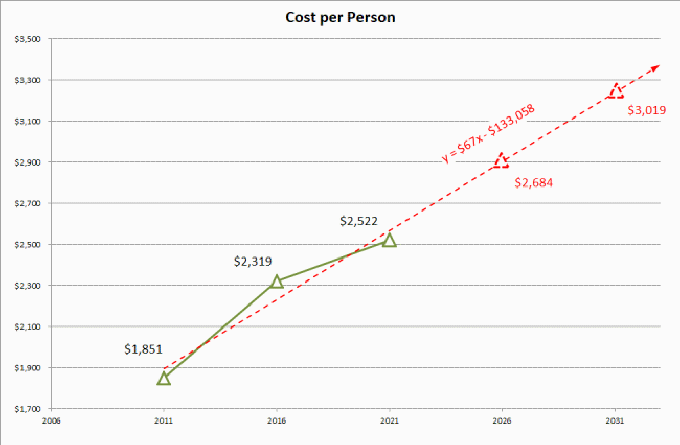Residential Tax Burden
 |
| Figure 4; Owen Soundís Total Expenses Divided by Population |
Residential Tax Burden
 |
| Figure 4; Owen Soundís Total Expenses Divided by Population |
Growing Tax Burden on a
per Capita Basis
Owen Soundís population declined in 2011 and again in 2016
based on data published by Statistics Canada. The 2021 census shows that the
population rebounded slightly to 21,612. Although this represented an increase
from the previous census it was still slightly less than the population from ten
years earlier in 2011 of 21,688.
By taking the total expenses from Figure 2, for the census years and dividing it by the population data we can calculate how much it costs to run the city per person. As shown in Figure 4, the cost per person steadily increased from $1,851 in 2011 to $2,522 in 2021. This is an increase of $671 per person or 36% over this ten year period. This is nearly double the rate of increase in the Consumer Price Index (CPI). The cost per person is increasing in spite of the population declining. According to Statistics Canada there are 141 fewer people in Owen Sound today then there were in 2011. Yet, the city is spending $13.2 million or 32.7 % more today than they spent delivering the same services to a larger population in 2011.So the question is: "Why does it cost more, to deliver city services, to fewer people?" We will show you exactly why this is in the next section of the report..
If we examine the trend line for this data we can calculate the cost per person using the equation for a straight line shown on the graph y=$67x-$133,058 When we put in the values for x of 2026 and 2031 we get the estimated cost per person of $2,684 and $3,019 respectively. This raises the question: if the population was declining during the period 2011 to 2020, why did expenses increase by $12.3 million or 30.7%? This ĎCost per Personí graph is another way of showing that the increasing cost of expenses was passed on directly to a declining population during the study period.
Owen Soundís Census data is available at the following links